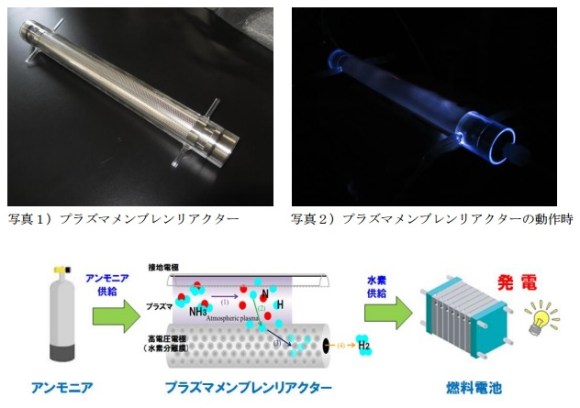
The Plasma Membrane Reactor can take a jug of ammonia and convert it into pure hydrogen cleanly and cheaply to power anything from portable generators to cars.
● What ever happened to Hydrogen?
Remember a few years back when everyone was talking about the advent of hydrogen fuel cell vehicles (FCV)? Toyota even jumped the gun and released a hydrogen car, the Mirai, to go along with Japan’s first ever hydrogen fueling station. But in the three years since then things have been relatively quiet on the FCV front.
Sure there are the superficial problems: there aren’t hydrogen stations on every street corner to fill up with and people are probably still a little skeptical about its safety after that whole Hindenberg disaster. Sure it’s been 80 years, but that’s no reason to let hydrogen get off easy.

More importantly, there have been deeper challenges, including storing the hydrogen. Calamity aside, the Hindenburg used hydrogen in the first place because it was extremely light. The problem with that is condensing it all together into a fuel tank so you can have a usable amount. Doing that will take a fair bit of pressure – 700 atm (10,000 psi) to be exact or about three times that of a typical scuba diving tank. Another way is to cool it enough so that it becomes a liquid, which would take temperatures of about -259℃ (-434°F).
Needless to say, storing and transporting fuel at either 700 times earth’s atmosphere or near the lowest temperature known to humanity at all times isn’t very cost effective. Even worse are the complex ways to acquire the hydrogen. Current methods to extract hydrogen from other substances often require considerable amounts of energy, meaning widespread usage of it might not even prove to be an environmentally friendly energy source at all.
So we need a better way.
● Ammonia: so much more than just a mirror cleaner
Ammonia, which is made up of one nitrogen atom and three hydrogen atoms, has long been considered a potential way to get pure hydrogen safely. It’s liquid at room temperature and although it is rather toxic in its undiluted state, it is relatively stable and much less flammable.
▼ The molecule also looks like it could give a mean foot massage
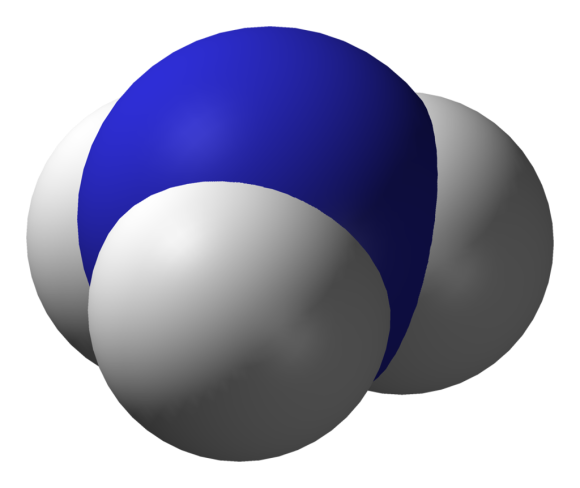
As desirable as it is, the problem is how to pull the hydrogen out of the ammonia. As I just mentioned, traditional methods are taxing and involve using temperatures of 400℃ to 800℃ (752°F to 1472°F) and rare materials like ruthenium as a catalyst. This brings us right back to the expensive environmental hazard of crazy temperatures and the possibility of making Canada really rich…you know, because they’re sitting on a lot of the ruthenium.
Luckily, Professor Shinji Kanbara of Gifu University and Sawafuji Electric have developed a way to easily, cheaply, cleanly, and compactly get the hydrogen out of ammonia without any extreme temperatures or pressures.
● The Plasma Membrane Reactor
This futuristic sounding device harnesses the often unsung hero of states of matter: plasma. Without getting too technical, plasma is a gas that has electricity passed through it and is split into positively and negatively charged components but still united as a single body of matter. Examples include fluorescent or neon lights and lightning.
▼ Those crazy lightning balls I used to love as a kid are a great example of plasma.
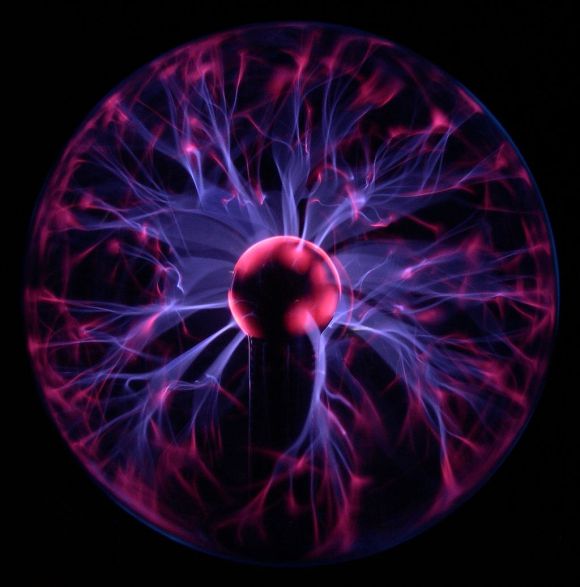
The design of the plasma membrane reactor is actually quite simple. It is made up of two tubes with one inside of the other. The outer tube is made of two-millimeter-thick quartz glass. Inside is a tube made of perforated iron wrapped in a thin film of palladium alloy.
Ammonia gas is passed through the small gap between the tubes while a high voltage current runs from the inner tube to the ground on the outer surface, thus creating ammonia plasma and separating the nitrogen and hydrogen atoms.
▼ As an added bonus, the plasma causes the reactor to emit a cool sci-fi glow
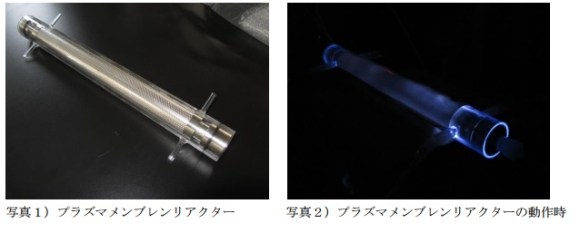
Only the single hydrogen atoms are able to pass through the palladium alloy and into the iron tube. On the other side they combine to form hydrogen gas which can then be fed directly into a hydrogen fuel cell.
▼ In this diagram showing how the Plasma Membrane reactor works, the red dots are nitrogen atoms and the blue dots are hydrogen atoms.
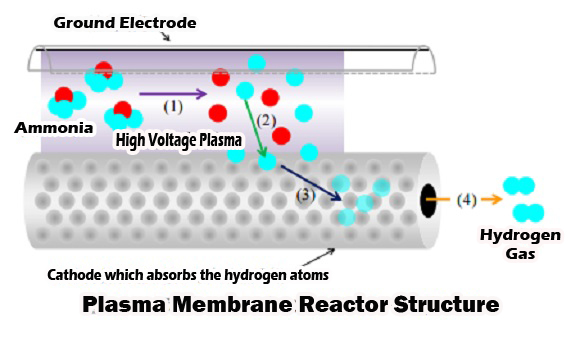
This process can be done at regular temperature and air pressure with considerably less energy and materials than other established methods. Not only that, a common problem with extracting hydrogen from ammonia had been that residual ammonia remains and corrodes the equipment over time. However, the Plasma Membrane Reactor produces hydrogen that is 99.999 percent pure.
● Big Deal?
It sure is. Ammonia to produce hydrogen is more cost-effective in pretty much every regard. Ammonia is relatively cheap and easier to transport and store as a fuel. It can be a great replacement for oil or diesel in generators without any of the harmful emissions providing clean power to rural areas or developing countries which don’t have access to gas or electricity.
With enough modifications it could also be incorporated into a hydrogen fuel cell powered vehicle. The device itself only measures about 4.2 by 40 centimeters (1.6 by 16 inches) and can produce enough hydrogen to reduce the fuel tank size from 120 Liters to 70 Liters (32 gallons to 18 gallons). With enough modification we may even have light enough gear to be able to have hydrogen fuel cell motorbikes as well.
▼ This video shows the inner workings of a Toyota Mirai with its two hydrogen tanks seen as yellow cylinders. Their size can be significantly reduced by the Plasma Membrane Reactor.
Granted, ammonia is rather toxic and therefore isn’t the safest material in the world, but we wouldn’t need any specialized and expensive facilities like hydrogen fuel stations to manage it. Anyone could sell ammonia with considerably fewer safety concerns than that of hydrogen or even gasoline.
The Plasma Membrane Reactor clears a major hurdle in hydrogen fuels cells by providing a cost-effective and environmentally friendly way of getting the hydrogen as well as a safer and more efficient way of storing it. It’s hard to imagine FCV and other hydrogen fuel cell manufacturers not wanting to utilize it.
And so, it certainly looks as if the future of cleaner energy is upon us, and it is very pungent smelling.
Source: Value Press
Feature image: Wikipedia/Benjah-bmm27
Top image: Value Press

 Japan’s hydrogen fuel cell stations begin to open, but are they worth the switch?
Japan’s hydrogen fuel cell stations begin to open, but are they worth the switch? Toyota’s hydrogen fuel cell powered car ready for sale this December
Toyota’s hydrogen fuel cell powered car ready for sale this December Honda readying a Fuel Cell Vehicle for buyers next year, just in time to challenge Toyota
Honda readying a Fuel Cell Vehicle for buyers next year, just in time to challenge Toyota Real Fullmetal Alchemists: Kyoto University team fuses all 8 precious metals into single alloy
Real Fullmetal Alchemists: Kyoto University team fuses all 8 precious metals into single alloy North Korea claims successful hydrogen bomb test, world very skeptical
North Korea claims successful hydrogen bomb test, world very skeptical Red light district sushi restaurant in Tokyo shows us just how wrong we were about it
Red light district sushi restaurant in Tokyo shows us just how wrong we were about it Japanese ramen restaurants under pressure from new yen banknotes
Japanese ramen restaurants under pressure from new yen banknotes Tokyo Tsukiji fish market site to be redeveloped with 50,000-seat stadium, hotel, shopping center
Tokyo Tsukiji fish market site to be redeveloped with 50,000-seat stadium, hotel, shopping center McDonald’s new Happy Meals offer up cute and practical Sanrio lifestyle goods
McDonald’s new Happy Meals offer up cute and practical Sanrio lifestyle goods Beautiful Red and Blue Star luxury trains set to be Japan’s new Hokkaido travel stars
Beautiful Red and Blue Star luxury trains set to be Japan’s new Hokkaido travel stars French Fries Bread in Tokyo’s Shibuya becomes a hit on social media
French Fries Bread in Tokyo’s Shibuya becomes a hit on social media Starbucks Japan adds a Motto Frappuccino to the menu for a limited time
Starbucks Japan adds a Motto Frappuccino to the menu for a limited time Sakura tree falls on man at Sannenzaka near Kiyomizu temple in Kyoto 【Breaking News】
Sakura tree falls on man at Sannenzaka near Kiyomizu temple in Kyoto 【Breaking News】 Pokémon Sleep camping suite and guestrooms coming to Tokyo Hyatt along with giant Snorlax burgers
Pokémon Sleep camping suite and guestrooms coming to Tokyo Hyatt along with giant Snorlax burgers All-you-can-drink Starbucks and amazing views part of Tokyo’s new 170 meter-high sky lounge
All-you-can-drink Starbucks and amazing views part of Tokyo’s new 170 meter-high sky lounge More foreign tourists than ever before in history visited Japan last month
More foreign tourists than ever before in history visited Japan last month Studio Ghibli releases new action figures featuring Nausicaä of the Valley of the Wind characters
Studio Ghibli releases new action figures featuring Nausicaä of the Valley of the Wind characters New private rooms on Tokaido Shinkansen change the way we travel from Tokyo to Kyoto
New private rooms on Tokaido Shinkansen change the way we travel from Tokyo to Kyoto Starbucks reopens at Shibuya Scramble Crossing with new look and design concept
Starbucks reopens at Shibuya Scramble Crossing with new look and design concept Studio Ghibli glasses cases let anime characters keep an eye on your spectacles
Studio Ghibli glasses cases let anime characters keep an eye on your spectacles Beautiful Ghibli sealing wax kits let you create accessories and elegant letter decorations【Pics】
Beautiful Ghibli sealing wax kits let you create accessories and elegant letter decorations【Pics】 Studio Ghibli releases Kiki’s Delivery Service chocolate cake pouches in Japan
Studio Ghibli releases Kiki’s Delivery Service chocolate cake pouches in Japan New definition of “Japanese whiskey” goes into effect to prevent fakes from fooling overseas buyers
New definition of “Japanese whiskey” goes into effect to prevent fakes from fooling overseas buyers Our Japanese reporter visits Costco in the U.S., finds super American and very Japanese things
Our Japanese reporter visits Costco in the U.S., finds super American and very Japanese things Studio Ghibli unveils Mother’s Day gift set that captures the love in My Neighbour Totoro
Studio Ghibli unveils Mother’s Day gift set that captures the love in My Neighbour Totoro New Japanese KitKat flavour stars Sanrio characters, including Hello Kitty
New Japanese KitKat flavour stars Sanrio characters, including Hello Kitty New Pokémon cakes let you eat your way through Pikachu and all the Eevee evolutions
New Pokémon cakes let you eat your way through Pikachu and all the Eevee evolutions Disney princesses get official manga makeovers for Manga Princess Cafe opening in Tokyo
Disney princesses get official manga makeovers for Manga Princess Cafe opening in Tokyo Sales of Japan’s most convenient train ticket/shopping payment cards suspended indefinitely
Sales of Japan’s most convenient train ticket/shopping payment cards suspended indefinitely Sold-out Studio Ghibli desktop humidifiers are back so Totoro can help you through the dry season
Sold-out Studio Ghibli desktop humidifiers are back so Totoro can help you through the dry season Japanese government to make first change to romanization spelling rules since the 1950s
Japanese government to make first change to romanization spelling rules since the 1950s Ghibli founders Toshio Suzuki and Hayao Miyazaki contribute to Japanese whisky Totoro label design
Ghibli founders Toshio Suzuki and Hayao Miyazaki contribute to Japanese whisky Totoro label design Doraemon found buried at sea as scene from 1993 anime becomes real life【Photos】
Doraemon found buried at sea as scene from 1993 anime becomes real life【Photos】 Tokyo’s most famous Starbucks is closed
Tokyo’s most famous Starbucks is closed One Piece characters’ nationalities revealed, but fans have mixed opinions
One Piece characters’ nationalities revealed, but fans have mixed opinions We asked a Uniqlo employee what four things we should buy and their suggestions didn’t disappoint
We asked a Uniqlo employee what four things we should buy and their suggestions didn’t disappoint Princesses, fruits, and blacksmiths: Study reveals the 30 most unusual family names in Japan
Princesses, fruits, and blacksmiths: Study reveals the 30 most unusual family names in Japan Japan government makes cute illustrated version of radioactive isotope it plans to dump into sea
Japan government makes cute illustrated version of radioactive isotope it plans to dump into sea Japanese teens develop anti-fart underwear that blocks smell and sound of flatulence
Japanese teens develop anti-fart underwear that blocks smell and sound of flatulence Japan’s JAXA wants to build a fuel processing plant on the surface of the moon
Japan’s JAXA wants to build a fuel processing plant on the surface of the moon Take a tour of the Fukushima Daiichi Nuclear Power Plant seven years after the disaster 【Video】
Take a tour of the Fukushima Daiichi Nuclear Power Plant seven years after the disaster 【Video】 Hugh Jackman stars, sings J-pop cover, and speaks Japanese in ads for Toyota【Videos】
Hugh Jackman stars, sings J-pop cover, and speaks Japanese in ads for Toyota【Videos】 Go to hell: Unzen Hot Springs invites visitors to take an infernal stroll through a field of deadly hell-mouths
Go to hell: Unzen Hot Springs invites visitors to take an infernal stroll through a field of deadly hell-mouths Synthetic fossil fuels made from light, water, and CO2 in the air tested in Osaka
Synthetic fossil fuels made from light, water, and CO2 in the air tested in Osaka Kansai man arrested for defrauding his 35 girlfriends
Kansai man arrested for defrauding his 35 girlfriends South Korean university develops toilet that converts poop to power and pays you for “deposits”
South Korean university develops toilet that converts poop to power and pays you for “deposits” Have a ghost problem in your house? Just use an air purifier, says Japanese Twitter user
Have a ghost problem in your house? Just use an air purifier, says Japanese Twitter user TEPCO in hot water for use of tasteless hashtag in recent tweet about Fukushima Nuclear Plant
TEPCO in hot water for use of tasteless hashtag in recent tweet about Fukushima Nuclear Plant Japanese team wins Ig Nobel prize for confirming that banana peels are in fact slippery
Japanese team wins Ig Nobel prize for confirming that banana peels are in fact slippery What’s really for breakfast? 20 Japanese people give us a peek at their morning meal【Photos】
What’s really for breakfast? 20 Japanese people give us a peek at their morning meal【Photos】 No more fuel! Young entrepreneur creates lantern that runs on ocean water
No more fuel! Young entrepreneur creates lantern that runs on ocean water Tearing down the ceiling at our cheap Japanese house in the countryside【SoraHouse】
Tearing down the ceiling at our cheap Japanese house in the countryside【SoraHouse】
Leave a Reply